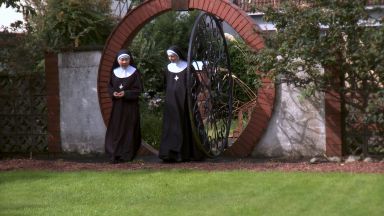 A former fashion and beauty photographer has released a 90-minute documentary on the life of Benedictine contemplatives.
A former fashion and beauty photographer has released a 90-minute documentary on the life of Benedictine contemplatives.
“Tyburn Convent Gloria Deo” brings viewers within the cloisters of the order’s nine monasteries, starting with the motherhouse in England, and ranging through Oceania and South America.
The order was established in 1903 near Marble Arch, London–the site where dozens of English martyrs were killed during the Protestant Reformation.
Michael Luke Davies created the work. He and Mother Xavier McMonagle, the mother-general of the Tyburn Nuns, presented the documentary last Thursday.
“I was moved to tears many times by the beauty of what I was filming,” Davies said. “For me, it exceeded my expectations of what I could film. It was an incredible experience I shall never forget for the rest of my life. The things I have seen and the moments I have shared with these beautiful religious people I will keep with me forever.”
The Tyburn Nuns, Adorers of the Sacred Heart of Jesus of Montmartre are an order of cloistered contemplative Benedictine nuns. The aim of the congregation is to glorify the Most Blessed Trinity, finding practical expression in daily Mass, the choral celebration of the Divine Office, perpetual adoration, and daily prayer for the Holy Father, the Church, the country and for the entire human family.
The Tyburn nuns were founded by Mother Marie Adele Garnier.
Born in 1838, her story is closely linked to St. Margaret Mary Alacoque, the 17th-century nun whose visions of Jesus led eventually to the construction of the Basilica of the Sacred Heart in Montmartre, Paris, in the late 19th century.
In 1872, Marie Adele, on hearing of the project to build the basilica, said she had received the interior message: It is there that I want you to be as a victim. Between 1876 and 1897 a small group of women had joined Marie Adele in Montmartre, attached to the basilica and praying day and night before the Eucharist.
However, they were uprooted when the French government passed the Law of Associations ordering the dissolution of all religious orders not authorized by the state.
Mother Marie Adele thus in 1901 set out for Notting Hill, London, where among the first things she did was to order four and a half gallons of beer in a perhaps light-hearted attempt to integrate into the life and customs of the nuns’ new country.
They found their mother house at Marble Arch. It was pointed out to the nuns that the location of the house 100 yards from the site of the former Tyburn Tree meant that it was in effect at the site of England’s Montmartre, or hill of martyrs.
Courtesy of ZENIT.
I’ve visited Tyburn Convent every time I was in London. Once I got to visit the Crypt, where there is the replica of the infamous ‘Tyburn Tree’ on which many of the martyrs were put to death. I also saw many relics of the martyrs, from bloodstained clothing to pieces of bones and hair (I think there was even a relic of St. Thomas More’s beard!).
The last two times I was in England (1997 and 1999) the hotel I stayed at in London was only a block or two from Tyburn Convent. So I was able to go to Mass several times. Two memorable Sunday Masses were on the days when St. Therese of Lisieux was made a Doctor of the Church (1997) and St. Edith Stein was canonized (1999). I was in the Secular Order of Discalced Carmelites during those years, so they were days of particular joy to me.
For a few years I received in the mail the Sisters’ newsletter, ‘Tyburn Talks’. They always came in envelopes that were made for Blessed John Paul II’s 1982 visit to the UK–my guess was that the envelopes had to get used up somehow, so the Sisters used them to send out the newsletter!